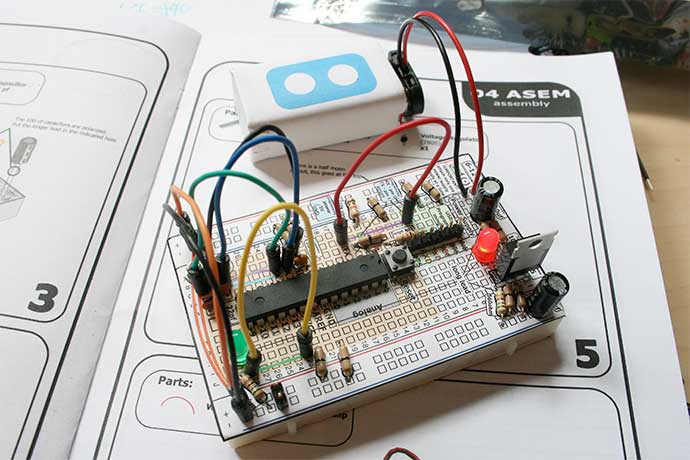Breadboards have many wonderful meanings. For chefs and people cooking, a breadboard is a flat board used to cut bread. For people working with Arduino, Beagle Board, or Raspberry Pi, a breadboard is flat board with holes to plug in wires to prototype and build electronic projects. Mechanical breadboards are used by mechanical engineers. And you can slice up your tomatoes or other food on breadboards.
Perhaps most interesting of all, electronic breadboards grew out of people using wooden breadboards to build their electronic circuits and projects.
For this article, however, we’ll look at how breadboards are used in electronic projects.
What Exactly is an Electronic Breadboard?
In electronics projects, a breadboard looks like this:

Electronic breadboards solve a simple problem: how do you quickly change connections to test different configurations as you create an electronic project? The traditional way to make connections between electronic components is to use solder and a soldering iron. That gets messy if you have to reconnect wires and components.
An electronic breadboard does away with solder and soldering irons. Instead, you connect your wires to and from plugs in the breadboard to make connections. This makes breadboards reusable.
Electronic breadboards are a sheet of plastic with uniform perforations or holes. Each hole contains a metal spring clip called a connection point or tie point. Each metal spring clip is wired underneath the plastic board, out of view. You only have to connect wires to the correct holes.
Breadboards typically contain rows or strips of connections:
- Terminal Strips are used to make connections between electronic components.
- Bus Strips are used to connect power to the breadboard and, from there, to the circuit.
Some electronic breadboards include both types of strips, others are dedicated to one type or another.
To make connections, you use small needle nose pliers or similar to press a wire into the electronic breadboard. The Learn More links below provide more details and examples how to use breadboards, including a project using a real wooden breadboard you might have in your kitchen.
Learn More
How to Use a Breadboard
https://learn.sparkfun.com/tutorials/how-to-use-a-breadboard
http://www.instructables.com/id/How-to-use-a-breadboard/?ALLSTEPS
What is a Breadboard?
http://en.wikipedia.org/wiki/Breadboard
Breadboard Tutorials
http://learn.adafruit.com/search?q=breadboard
http://www.instructables.com/id/Use-a-real-Bread-Board-for-prototyping-your-circui/
http://www.sciencebuddies.org/science-fair-projects/project_ideas/Elec_primer-simplecircuit.shtml

